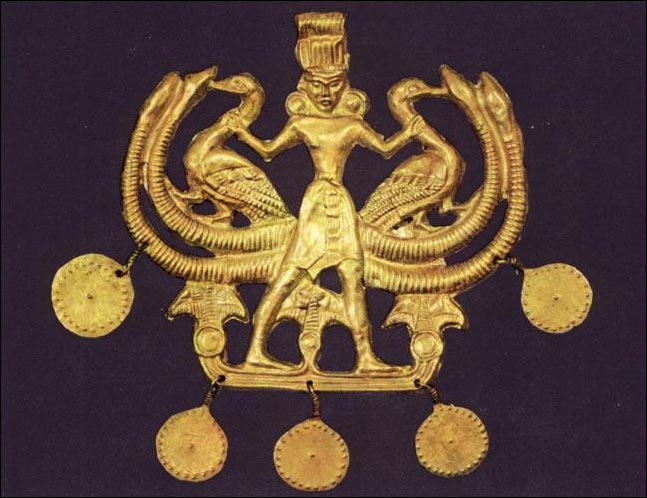Date
ca. 1800-1700 B.C.
Origin
The Classical World : Pre-Hellenic Era : Crete : First Palace Period
: Middle Minoan Ib, II
Description
Lord of the Beasts; standing male figure facing frontally, feet and
legs turned to right, wearing loincloth tied at waist, two bracelets
on each arm, wide circular earrings, headdress with four vertical feathers
surmounted by hollow fluted cylinder, grasping neck of waterbird in
each hand, standing on flat boat-like structure with lotus flower terminals
and single lotus in center between deity's legs, two curved and ribbed
objects (branches?; snakes?) emerging from (or behind?) figure at thigh
level, outer ones resting on lotus flower terminals of base, birds pecking
at 'buds' of inner branches(?); five circular pendant forms decorated
with punched dots hanging from piece, three from 'boat' and two from
outer branches.
In the matriarchal society of Minoan Crete, the Lady of the Beasts was
a dominant religious element, appearing on many Middle and Late Minoan
gems and seal impressions (see 3Cd.058). Her male counterpart, the Lord
of the Beasts, is seen far more rarely, and his late appearance may
reflect the gradual transition toward a patriarchal order. He is usually
seen flanked by a pair of lions (3Cd.040). Occasionally he grasps the
throats of two long-necked waterbirds, thereby prefiguring the role
of the Potnia Theron of the seventh century B.C., at which time the
growing strength of the patriarchate was reflected in the emphasis given
to her negative and destructive aspects (see 3Ge.013). It should be
noted that in our piece, the birds do not seem to be held in a strangling
grasp as in the later representations of the goddess. Rather, the god,
while controlling, elevates them, perhaps in an effort to emphasize
his life-sustaining capacity.
Nilsson points out the apparently close relationship between the objects
which seem to emerge from, or continue behind, the body of the deity
and recognized representations of the Lord and Lady of the Beasts (see
also 3Cd.058). On most of these examples, however, the curved forms
are placed above the divine image. But the three dimensional nature
of the pendant may have necessitated this peculiar arrangement. Most
certainly we are dealing with an early symbol of the Minoan nature god
- a symbol which could be applied to either the masculine or feminine
aspects of the divinity.
The specific prototype for these forms is unclear. They may reflect
floral motives, but Evans feels that they were ceremonial 'snake frames.'
Nilsson comments on their similarity with snakes but is forced to conclude
that "At all events, the object is here a motif transmitted from
an older age and perhaps not wholly understood." Holland (in AJA)
has endeavored to relate them to obscure Anatolian derivitives.
The apparently Egyptian influence (the 'lotus boat,' the earrings which
bear a close resemblance to Hathor's coiffure, and the posture of the
figure) is mentioned by Higgins.
Object
Pendant (gold; ht. 2 3/8").
Style or School
"About 1800-1700 B.C.(?)" [--Demargne.]
Material or Technique
Metal.
Provenance
From the so-called Aegina Treasure which was reportedly discovered in
a Mycenaean tomb on the island of Aegina. Recent studies have demonstrated
that the Treasure was of Cretan origin, possibly from Mallia (cf. 3Cc.018)
and dates to the seventeenth century B.C. [--Higgins.]
Repository or Site
London: Mus., British.
Image Sources
from Demargne.* [JF 5083]
References
*Demargne, P., Birth (1964), p.438; pl.150.
Higgins, R., Minoan (1967), pp.44,46,48; ill.40.
Nilsson, M.P., Minoan (1950), pp.362,367-68; fig.177(94).
AJA, XXXIII (1939), pp.190-91.
Hutchinson, R.W., Prehistoric (1962), p.208.
|

